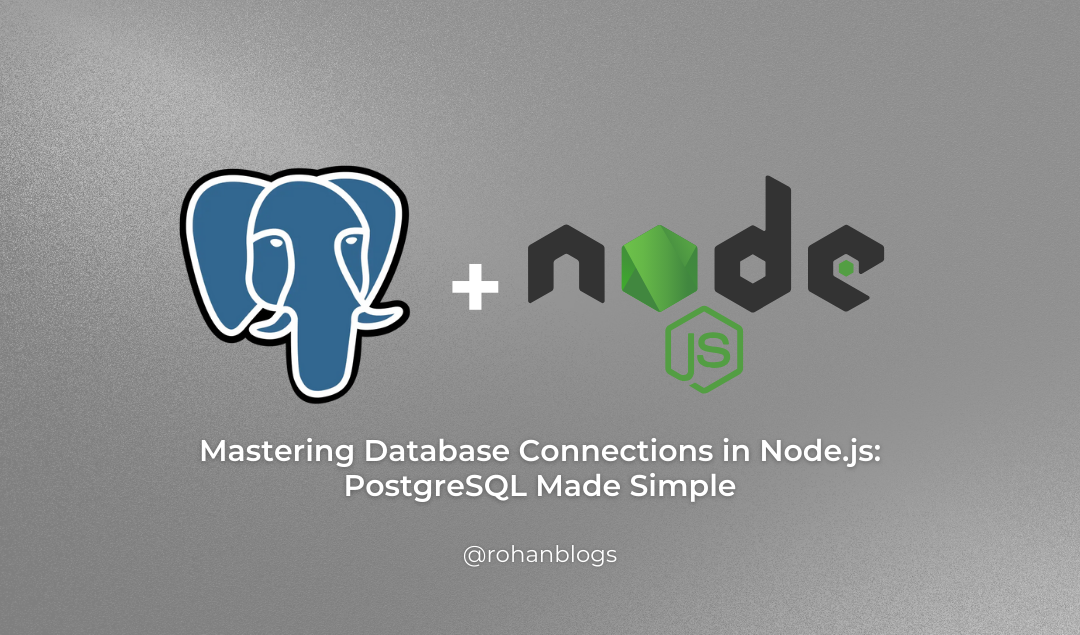Scaling Heights: Integrating PostgreSQL with Node.js for Robust Performance
 Rohan Shrivastava
Rohan Shrivastava
In the realm of modern web development, integrating databases with server-side applications is crucial for storing and managing data efficiently.
PostgreSQL (Postgres) stands out as a powerful and versatile relational database management system (RDBMS) that seamlessly integrates with Node.js, a popular server-side JavaScript runtime environment.
This article will walk you through the process of connecting PostgreSQL with a Node.js server, highlight its importance, unique features, and compare it with MongoDB, a popular NoSQL database.
Importance of PostgreSQL
PostgreSQL has gained widespread adoption due to its robust features and reliability in handling complex queries and transactions.
Here are some key reasons why PostgreSQL is highly regarded:
Relational Model: PostgreSQL follows a relational database model, allowing developers to define and maintain relationships between different data entities easily.
ACID Compliance: It ensures Atomicity, Consistency, Isolation, and Durability (ACID properties), making it suitable for applications that require strong data consistency and reliability.
Extensibility: PostgreSQL supports a rich set of data types, indexing techniques, and advanced features like JSONB (for storing JSON data efficiently) and full-text search capabilities.
Scalability: It scales well both vertically (by adding more resources to a single server) and horizontally (by distributing data across multiple servers).
Community Support: Being open-source, PostgreSQL benefits from a large and active community that continually contributes to its development and maintenance.
Connecting PostgreSQL with Node.js
To connect PostgreSQL with a Node.js server, follow these steps:
Install PostgreSQL: Download and install PostgreSQL from postgresql.org.
Set Up a Database: Create a database and tables using the PostgreSQL command-line interface (CLI) or a graphical tool like pgAdmin.
Install Required Packages: In your Node.js project directory, install
pg(node-postgres) package using npm:Copy codenpm install pgConfigure Connection: Use
pgto establish a connection to your PostgreSQL database in your Node.js application:javascriptCopy codeconst { Pool } = require('pg'); const pool = new Pool({ user: 'your_username', host: 'localhost', database: 'your_database_name', password: 'your_password', port: 5432, // default PostgreSQL port }); // Example query execution pool.query('SELECT NOW()', (err, res) => { if (err) { console.error('Error executing query', err.stack); } else { console.log('Query result:', res.rows[0]); } pool.end(); // close the pool });Execute Queries: Use the
querymethod of the pool to execute SQL queries against your PostgreSQL database.
Comparison with MongoDB
MongoDB, a popular NoSQL database, differs from PostgreSQL in several ways:
Data Model: MongoDB uses a flexible, schema-less document model (JSON-like), while PostgreSQL uses a rigid relational schema.
Scaling: MongoDB excels at horizontal scaling and can handle large volumes of unstructured or semi-structured data more easily than PostgreSQL.
Query Language: PostgreSQL uses SQL for querying, whereas MongoDB uses a JavaScript-based query language.
Transactions: MongoDB introduced multi-document ACID transactions in recent versions, while PostgreSQL has supported transactions traditionally.
Advantages and Disadvantages
PostgreSQL Advantages:
Strong consistency and data integrity.
Rich SQL support with powerful querying capabilities.
Suitable for complex transactions and relational data.
Mature, stable, and well-documented.
PostgreSQL Disadvantages:
Requires more initial setup and configuration compared to NoSQL databases.
Scaling horizontally can be more complex compared to NoSQL solutions like MongoDB.
MongoDB Advantages:
Flexible schema allows for agile development and handling of diverse data types.
Scalable horizontally with ease.
Native support for sharding and replication.
MongoDB Disadvantages:
Eventual consistency model may lead to data integrity challenges.
Less mature SQL-like querying capabilities compared to PostgreSQL.
Conclusion
Choosing between PostgreSQL and MongoDB depends on your application's specific requirements.
If your application demands strong consistency, relational integrity, and complex queries, PostgreSQL is an excellent choice.
Conversely, if you prioritize scalability, flexible schema design, and handling of large volumes of unstructured data, MongoDB might be more suitable.
Understanding these differences and capabilities will empower you to make informed decisions when architecting your Node.js applications with database integration.
In conclusion, PostgreSQL's reliability, robust feature set, and SQL compliance make it a preferred choice for many developers, while MongoDB's flexibility and scalability appeal to others handling diverse or rapidly evolving data needs.
Whichever you choose, both databases offer powerful tools to build scalable and performant applications.
Subscribe to my newsletter
Read articles from Rohan Shrivastava directly inside your inbox. Subscribe to the newsletter, and don't miss out.
Written by

Rohan Shrivastava
Rohan Shrivastava
Hi, I'm Rohan, a B.Tech graduate in Computer Science (Batch 2022) with expertise in web development (HTML, CSS, JavaScript, Bootstrap, PHP, XAMPP). My journey expanded with certifications and intensive training at Infosys, covering DBMS, Java, SQL, Ansible, and networking. I've successfully delivered projects, including a dynamic e-commerce site and an Inventory Management System using Java. My proactive approach is reflected in certifications and contributions to open-source projects on GitHub. Recognized for excellence at Infosys, I bring a blend of technical proficiency and adaptability. Eager to leverage my skills and contribute to innovative projects, I'm excited about exploring new opportunities for hands-on experiences. Let's connect and explore how my skills align with your organization's goals.